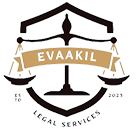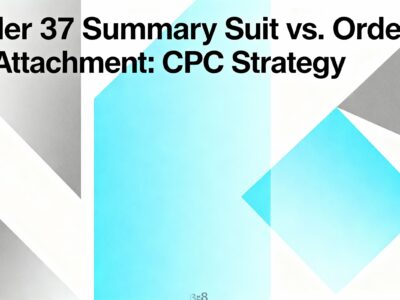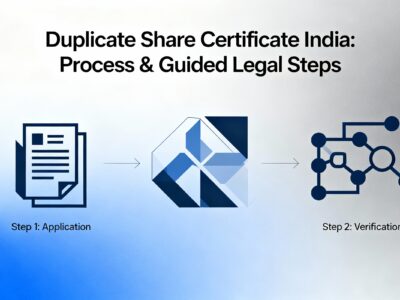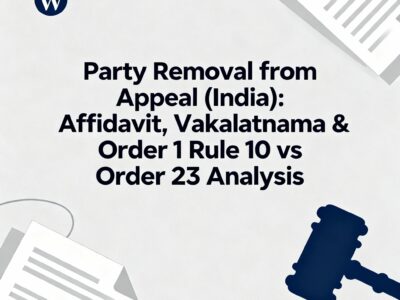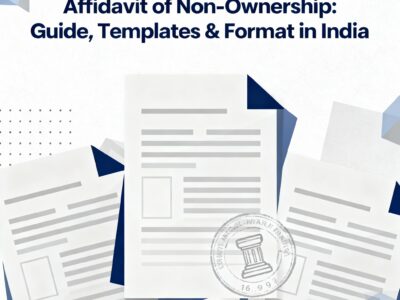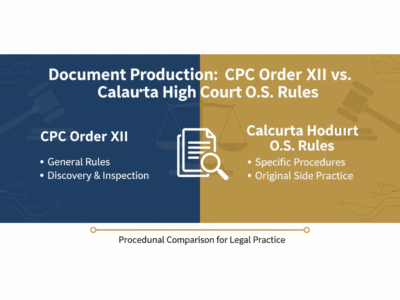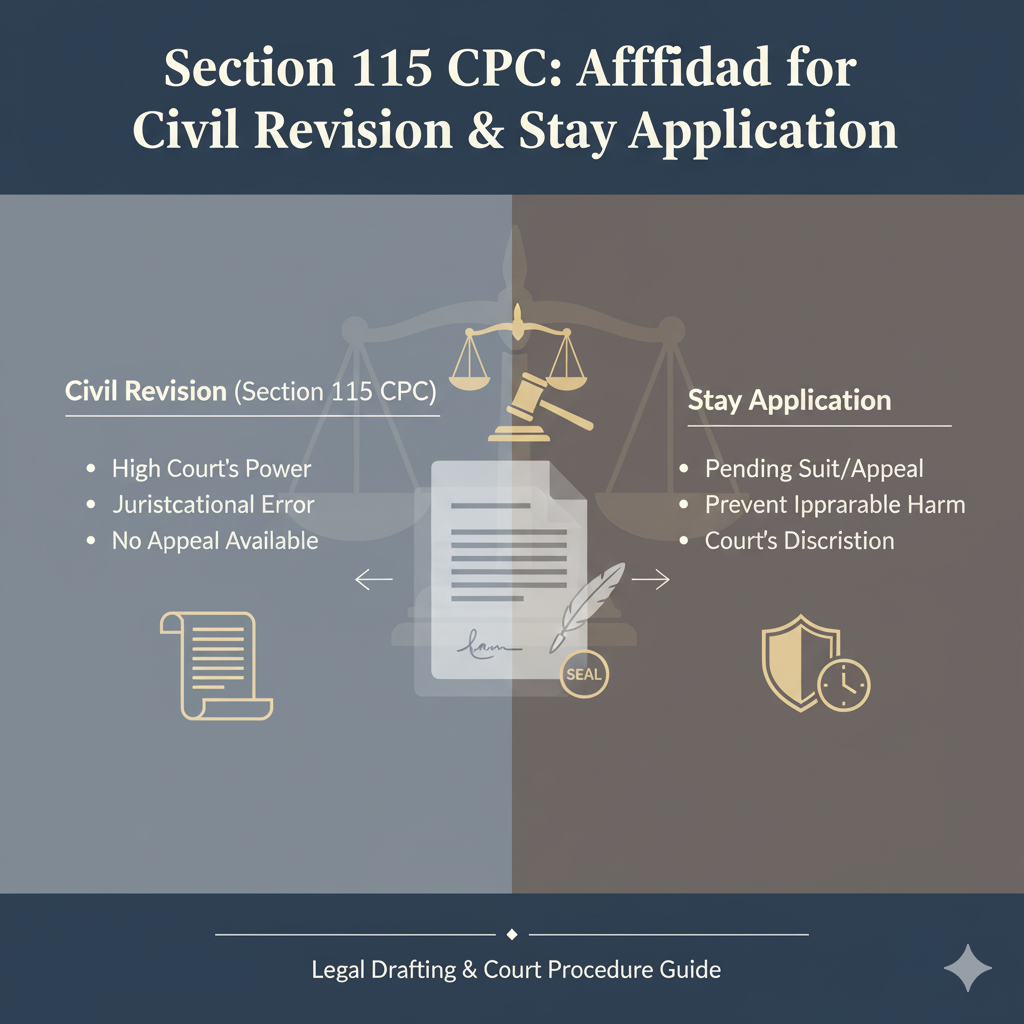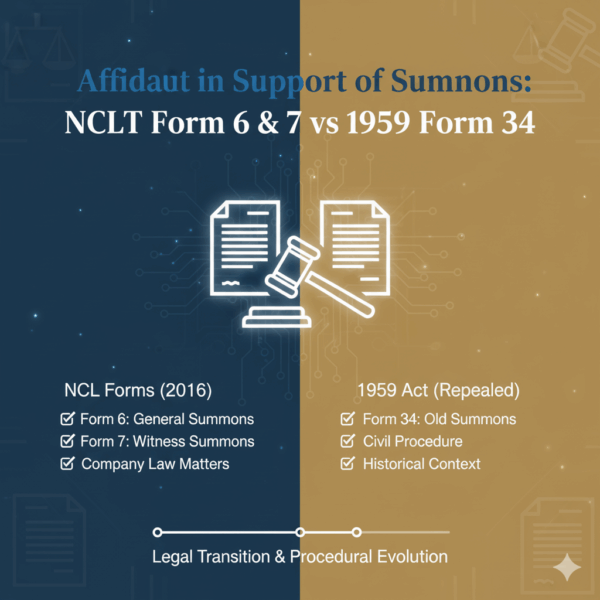Welcome to evaakil.com’s deep dive into two critical Indian legal documents. This 2025 guide provides a detailed analysis of filing an Affidavit in Support of an Injunction in a Civil Revision Petition, covering the “three pillars” of prima facie case, irreparable injury, and balance of convenience.
We then explore the high-stakes world of commercial debt by breaking down an Acknowledgment of Arrears of Licence Fees. Learn the vital differences between a simple acknowledgment under Section 18 of the Limitation Act and a promise to pay a time-barred debt under the Indian Contract Act.
Affidavit in Support of an Injunction Application in a Civil Revision Petition
Updated: October 28, 2025
Document Type: Legal Precedent (No. 23)
Court Level: High Court
1. Document Identification and Purpose
This document is a legal precedent (Precedent No. 23) for an Affidavit. It is filed by the Petitioner in support of a Civil Miscellaneous Petition. This miscellaneous petition is an interlocutory application within a larger Civil Revision Petition filed before the Hon'ble High Court.
The specific purpose of this affidavit is to request that the High Court pass an order for an "ad interim injunction". This injunction seeks to restrain the Respondent from disposing of (selling, transferring, etc.) the suit property to any third party while the Civil Revision Petition is being decided.
2. Summary of Factual Background
The affidavit outlines the following sequence of events that led to the current Revision Petition:
- Original Suit: The Petitioner (who is the deponent of this affidavit) filed an original suit (O.S. No...) before the Principal Sub-Judge.
- Relief Sought in Suit: The goal of that suit was to obtain a permanent prohibitory injunction to stop the defendant (now the Respondent) from disposing of the suit property.
- Temporary Injunction Application: Along with the main suit, the Petitioner filed an application for a temporary injunction (I.A. No...) to prevent the Respondent from selling the property during the pendency of the suit.
- Lower Court's Action: The Petitioner alleges that the Sub-Judge did not take up the injunction application for hearing, despite repeated requests.
- Preliminary Issue: Instead, the Respondent's lawyer made an oral application to first decide the maintainability of the suit and the court's jurisdiction as a preliminary issue.
- Dismissal Order: The Sub-Judge, without hearing the injunction application, passed an Order that found the issues of jurisdiction and maintainability against the Petitioner.
- Civil Revision Petition: The Petitioner, feeling "aggrieved by the abovesaid Order," filed the current Civil Revision Petition in the High Court to challenge that decision.
3. Justification for Urgent Injunction
The affidavit presents the following key arguments to establish the urgency and necessity of the injunction:
The Three Pillars of an Injunction Plea
Prima Facie Case
The Petitioner must show a strong initial case that their rights are being violated.
Irreparable Injury
The harm faced must be one that cannot be compensated adequately with money.
Balance of Convenience
The inconvenience to the Petitioner if the injunction is denied must outweigh the inconvenience to the Respondent if it is granted.
- Respondent's Actions: The Petitioner claims the Respondent is "taking undue advantage" of the situation and has "speeded up his negotiations with prospective buyers" to sell the suit property.
- Irreparable Injury: If the Respondent is allowed to sell the property, the Petitioner argues that the "very purpose of the suit will stand defeated". This would cause the Petitioner "irreparable injury" which "will not be capable of being remedied by way of damages" (meaning monetary compensation would not be sufficient).
- Balance of Convenience: The affidavit asserts that the "balance of convenience is in favour of the injunction being granted".
- No Harm to Respondent: It further claims that granting the injunction will not "adversely affect [or] jeopardize the respondent's lawful rights" while the revision is pending.
4. Structure and Formalities
The document follows the standard structure of a legal affidavit in India:
Key Components of an Affidavit
Caption
Name of the Court, Petition numbers, and party names (Petitioner vs. Respondent).
Deponent's Introduction
Identification of the person swearing the affidavit, their connection to the case, and competence to swear.
Numbered Paragraphs
A clear and logical presentation of the facts and arguments supporting the petition.
Verification & Attestation
The deponent swears the contents are true, signs, and affirms the oath before an authorized official.
- Caption: It begins with the name of the court (BEFORE THE HON'BLE HIGH COURT OF...) and the case details (Petition numbers, Petitioner vs. Respondent).
- Deponent's Introduction: The person swearing the affidavit (the deponent) identifies themselves, their relation to the case (the Petitioner), and swears they are "well conversant with the facts" and "competent to swear" the affidavit.
- Numbered Paragraphs: The facts and arguments are laid out in numbered paragraphs.
- Verification: The document ends with a Verification clause. Here, the deponent swears that the contents are "true and correct to the best of my knowledge, belief and information and nothing material has been concealed therefrom".
- Attestation: It includes sections for the deponent to sign and for the oath to be "solemnly affirmed and signed before" an authorized official (like a Notary or Oath Commissioner) who personally knows the deponent.
Note: A final note clarifies that the affidavit must be attested by the appropriate authority and advises that affidavits should primarily state facts, avoiding prayers "to the possible extent".
5. Strategic Considerations for the Deponent (Petitioner)
Filing an affidavit for an ad interim injunction is a critical, time-sensitive action. The deponent's statement must be robust and persuasive. Here are key strategic points to consider:
- Conveying Urgency: The affidavit must establish *why* the court needs to act immediately. Phrases like "speeded up his negotiations" (as used in the precedent) are vital. The deponent must show that the threat is not just possible, but imminent.
- Supporting Evidence (Annexures): While the affidavit itself contains facts, its strength is multiplied by supporting documents. These should be attached as "Annexures" and referred to in the affidavit. Examples include:
- A copy of the original suit (plaint).
- The lower court's order being challenged.
- Any communication (e.g., letters, emails) suggesting the respondent's intent to sell.
- Photographs or property records.
- Anticipating Defenses: A strong affidavit briefly addresses potential counter-arguments. By stating that granting the injunction "will not adversely affect... the respondent's lawful rights," the petitioner is proactively addressing the "balance of convenience" pillar.
Best Practices for Drafting
- First-Person, Personal Knowledge: The affidavit must be in the first person ("I, [Name]..."). The deponent must clearly distinguish between facts they know personally and facts they believe to be true based on information received (and stating the source of that information).
- State Facts, Not Legal Arguments: The affidavit's job is to state facts. The accompanying petition or the lawyer's oral submissions will make the legal arguments based on those facts. For example:
- Fact (Good): "On October 25, 2025, I saw the Respondent showing the suit property to three unknown persons."
- Argument (Bad): "The Respondent is therefore clearly in violation of the principles of natural justice."
- Be Specific and Unambiguous: Vague statements weaken the affidavit. Use dates, names, and specific actions whenever possible.
6. Common Challenges and Respondent's Defenses
The respondent will file a counter-affidavit to defeat the injunction application. Understanding these common challenges helps the petitioner draft a more resilient initial affidavit.
How a Respondent Might Contest the Injunction
| Basis of Challenge | Respondent's Likely Argument |
|---|---|
| Concealment of Material Facts | "The Petitioner has not approached the court with 'clean hands.' They failed to disclose [a key fact] which, if known, would disqualify them from receiving this equitable relief." |
| No Prima Facie Case | "The Petitioner's main suit is frivolous, vexatious, and has no chance of success. The court should not grant an injunction based on a meritless claim." |
| No Irreparable Injury | "Any alleged harm is purely financial. If the Petitioner wins the suit, they can be compensated with money (damages). This is not an 'irreparable' injury." |
| Balance of Convenience | "The injunction will cause me (the Respondent) far greater harm than the Petitioner seeks to avoid. It will prevent me from completing a critical business deal, causing immense financial loss." |
| Delay (Laches) | "The Petitioner knew about my intention to sell for six months but did nothing. Their sudden urgency is manufactured. They have slept on their rights, and the court should not aid them now." |
| Jurisdictional Issues | "As the lower court correctly found, this court (or the original court) does not have the proper jurisdiction to hear this matter or grant this relief." (This is directly relevant to the precedent). |
7. Types of Injunctions in Indian Civil Law
The term "injunction" covers several distinct court orders that serve different purposes at different stages of a lawsuit. Understanding these types provides context for the "ad interim" relief sought in the affidavit.
| Type of Injunction | Legal Provision (Code of Civil Procedure, 1908) | When Granted | Duration |
|---|---|---|---|
| Ad Interim Injunction | Order 39, Rules 1 & 2 | Granted at the very beginning, often *ex-parte* (without hearing the respondent) due to extreme urgency. This is what the precedent affidavit is for. | Very short-term; lasts only until the respondent appears and the court hears the main temporary injunction application. |
| Temporary Injunction | Order 39, Rules 1 & 2 | Granted after hearing both parties (or after the ad interim stage). It requires the petitioner to prove the "three pillars" (Prima Facie Case, Irreparable Injury, Balance of Convenience). | Lasts for the entire duration of the main suit, until the final judgment is passed. |
| Permanent (Perpetual) Injunction | Specific Relief Act, 1963 | Granted only at the end of the trial as part of the final judgment (decree) if the petitioner successfully proves their entire case. | It is final and lasts forever (in perpetuity). |
8. The Petitioner's 'Undertaking as to Damages'
A crucial aspect of seeking an injunction, which is often included in the application or affidavit, is the "undertaking as to damages." This is a mandatory procedural requirement in many courts.
An undertaking is a solemn promise to the court. In this context, the petitioner (the person asking for the injunction) promises that if the court grants the injunction but later determines, at the end of the trial, that the injunction should not have been granted, the petitioner will compensate the respondent for any and all damages they suffered because of that injunction.
Why is this required? Granting an ad interim or temporary injunction is a significant use of judicial power. It restricts the respondent's rights (e.g., their right to sell their property) *before* the case has been fully proven. The undertaking acts as a financial safeguard, ensuring that the respondent has a way to recover their losses if the petitioner's case fails and the injunction is found to be unjustified.
This requirement forces the petitioner to be serious about their claim. A petitioner who is not confident in their case may be hesitant to give such a binding financial undertaking, as they would be personally liable for the respondent's losses.
Acknowledgment of Arrears of Licence Fees in India
Updated: November 2, 2025
Document Type: Commercial Document
Governing Law: Indian Contract Act, 1872; Limitation Act, 1963
1. What is an Acknowledgment of Arrears?
An "Acknowledgment of Arrears of Licence Fees" is a formal written statement by a licensee (the person or entity granted a license) admitting that they owe a specific amount of unpaid licence fees to the licensor (the person or entity who granted the license). This document serves as a clear admission of debt.
It is most commonly used in commercial leasing and licensing agreements, such as renting a shop, using a brand name, or operating under a specific permit where regular fees are required.
2. Primary Purpose and Legal Significance
The main function of this document is to formally record the existence of the debt. Its legal significance is substantial, particularly concerning the Limitation Act, 1963.
- Restarting the Limitation Period: Under Section 18 of the Limitation Act, a fresh period of limitation starts from the date on which the debtor (the licensee) signs the acknowledgment of liability.
- Example: If the original due date for the fees was January 1, 2022, the licensor typically has 3 years (until January 1, 2025) to file a suit for recovery. If the licensee signs an acknowledgment on December 1, 2024, a new 3-year limitation period begins from that date.
- Evidence of Debt: It serves as powerful evidence in a court of law, making it much easier for the licensor to prove their claim in a recovery suit.
- Basis for Negotiation: It often forms the basis for a new payment plan, settlement, or restructuring of the outstanding debt.
Crucial Requirement: For an acknowledgment to be valid under Section 18 of the Limitation Act, it must be (1) in writing, (2) signed by the debtor (or their agent), and (3) made *before* the original limitation period expires.
3. Key Components of the Document
A well-drafted acknowledgment should be clear, unambiguous, and include the following details:
Drafting an Acknowledgment of Arrears
Identify Parties
Full legal names and addresses of the Licensor (creditor) and Licensee (debtor).
Reference Agreement
Clearly state the original Licence Agreement, its date, and the property or right it pertains to.
Admit Specific Sum
State the exact amount of arrears due (e.g., "Rs. 1,50,000") and the period it relates to (e.g., "for June 2024 to October 2024").
Signature and Date
Must be signed by the licensee (or authorized signatory) and clearly dated. This date is critical for limitation purposes.
4. Acknowledgment vs. Promissory Note
It is important to distinguish an acknowledgment from other financial documents.
| Feature | Acknowledgment of Debt | Promissory Note |
|---|---|---|
| Primary Purpose | To admit an *existing* debt. | To *promise* to pay a certain sum of money. |
| Nature | An admission of a past fact. | A creation of a new, unconditional promise. |
| Legal Effect | Primarily resets the limitation period (Sec. 18, Limitation Act). | Is a negotiable instrument (under Negotiable Instruments Act, 1881). Can be sued upon directly. |
| Promise to Pay | Does not need to contain an express promise to pay (though it can). | *Must* contain an express, unconditional promise to pay. |
| Stamping | May require nominal stamping depending on state laws. | Must be properly stamped as per the Indian Stamp Act to be admissible as evidence. |
Debt Recovery Timeline: Impact of Acknowledgment
This chart illustrates how an acknowledgment extends the time available for legal action.
5. Risks and Considerations for the Licensee
While an acknowledgment can be a useful tool for negotiating a payment plan, the licensee (debtor) must understand the significant legal rights they are altering when they sign.
- Immediate Admissibility: The document is a clear, written admission of liability. If the licensor sues, this document makes their case extremely strong and difficult to defend.
- Waiver of Defenses: By signing, the licensee may unintentionally give up their right to dispute the debt. For example, they can no longer easily argue that:
- The licensor failed to provide services.
- The premises were unusable.
- There were other breaches of the original agreement by the licensor.
- Revival of Time-Barred Debt: This is the most serious risk. If a debt is old (e.g., more than 3 years), it may be "time-barred," meaning the licensor has lost the right to sue for it. Signing an acknowledgment *restarts* this 3-year clock, bringing a "dead" debt back to life.
Checklist Before Signing an Acknowledgment
Verify the Amount
Is the principal sum correct? Does it include interest or penalties you have not agreed to?
Check the Period
Does the document accurately state the months or years for which the fees are due? Ensure there is no overlap.
Note Counter-Claims
If the licensor owes *you* money, this acknowledgment should be part of a "settlement," not a one-sided admission.
Seek Legal Advice
Before signing, especially for large amounts, have a lawyer review the document and its implications.
6. Enforcement and Next Steps After Acknowledgment
The acknowledgment is often the beginning of a resolution, not the end. Here is what typically happens next.
For the Licensor (Creditor)
- Create a Payment Plan: The most common next step is to attach the acknowledgment to a new "Payment Agreement" or "Settlement Deed" that outlines a clear schedule for paying the admitted arrears.
- Hold in Abeyance: The licensor may agree to "hold in abeyance" (pause) legal action, on the condition that the licensee adheres to the new payment plan.
- File a Recovery Suit: If the licensee signs the acknowledgment but still fails to pay, the licensor can file a civil suit for recovery. This acknowledgment becomes 'Exhibit A' and makes the case much faster, potentially qualifying for a "Summary Suit" (Order XXXVII of the CPC) which is a speedier legal process.
For the Licensee (Debtor)
- Adhere to the New Terms: The licensee must strictly follow the new payment plan that is typically created alongside the acknowledgment.
- Obtain Receipts: For every payment made towards the acknowledged arrears, the licensee must obtain a separate, clear receipt that states the payment is "towards the acknowledged sum of [Amount] dated [Date]."
- Secure a "No Dues Certificate": Once the entire acknowledged amount is paid off, the licensee must request a formal "Full and Final Settlement" letter or a "No Dues Certificate" from the licensor. This document formally extinguishes the debt and prevents future claims.
7. Acknowledgment vs. Settlement Agreement
As mentioned in the "Next Steps," an acknowledgment is often *part* of a larger settlement, but it is not the same thing. Understanding this distinction is vital for both parties.
| Feature | Acknowledgment of Debt | Settlement Agreement (or Deed) |
|---|---|---|
| Scope | Narrow. Admits one single fact: a specific debt is owed. | Broad. Resolves an entire dispute between parties. |
| Purpose | To confirm a debt and, primarily, to reset the limitation period. | To create a new set of binding obligations and rights that replace the old ones. |
| Legal Status | An admission; strong evidence. | A new, standalone contract that can be enforced on its own terms. |
| Creates New Rights? | No. It only confirms existing rights and liabilities. | Yes. It creates new rights (e.g., a payment schedule) and obligations (e.g., waiver of claims). |
| Typical Use | "I agree I owe you Rs. 50,000." | "I agree I owe you Rs. 50,000, and I will pay it in 5 installments. In return, you agree to waive all interest and not to sue me as long as I am paying." |
8. Key Distinction: Promise to Pay a Time-Barred Debt
The "Crucial Requirement" note in Section 2 stated that a Section 18 acknowledgment must be made *before* the limitation period expires. So, what happens if the debt is already time-barred (e.g., 4 years old)?
This is where a different law applies: Section 25(3) of the Indian Contract Act, 1872. This provision states that a promise to pay a time-barred debt is a valid and enforceable *new contract*, even though there was no new "consideration" (the past debt itself is the consideration).
The Two "Time" Rules: A Summary
- Before Limitation Expires (Sec. 18, Limitation Act): If you sign a simple *acknowledgment* of the debt, the 3-year clock restarts from that date. The original debt continues.
- After Limitation Expires (Sec. 25(3), Contract Act): An *acknowledgment* does nothing. You must sign an express *promise to pay* the specific debt. This creates a brand new, enforceable contract.
This is a critical legal difference. A licensor trying to recover a 4-year-old debt cannot simply get the licensee to sign an "acknowledgment." They must get the licensee to sign a new document that says, "I know this debt of Rs. 1,00,000 is time-barred, but I promise to pay it." This new promise is legally binding.
